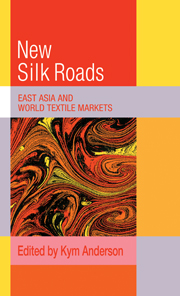Book contents
- Frontmatter
- Contents
- List of figures
- List of tables
- Contributors to this volume
- Preface
- Abbreviations and acronyms
- Symbols
- Introduction and summary
- I FIBRES, TEXTILES AND ECONOMIC DEVELOPMENT
- II DEMAND FOR TEXTILE EXPORTS FROM NEWLY INDUSTRIALIZING ASIA
- III CONCLUSIONS
- Appendix: Data on world production, consumption and trade in textiles, clothing and fibres
- Bibliography
- Index
Introduction and summary
Published online by Cambridge University Press: 19 January 2010
- Frontmatter
- Contents
- List of figures
- List of tables
- Contributors to this volume
- Preface
- Abbreviations and acronyms
- Symbols
- Introduction and summary
- I FIBRES, TEXTILES AND ECONOMIC DEVELOPMENT
- II DEMAND FOR TEXTILE EXPORTS FROM NEWLY INDUSTRIALIZING ASIA
- III CONCLUSIONS
- Appendix: Data on world production, consumption and trade in textiles, clothing and fibres
- Bibliography
- Index
Summary
There seems to be a happy concurrence of causes in human affairs, which checks the growth of trade and riches, and hinders them from being confined entirely to one people; as might naturally at first be dreaded from the advantages of an established commerce. Where one nation has gotten the start of another in trade, it is very difficult for the latter to regain the ground it has lost; because of the superior industry and skill of the former, and the greater stocks, of which the merchants are possessed, and which enable them to trade on so much smaller profits. But these advantages are compensated in some measure, by the low price of labor in every nation which has not an extensive commerce, and does not much abound in gold and silver. Manufactures therefore gradually shift their places, leaving those countries and provinces which they have already enriched, and flying to others, whither they are allured by the cheapness of provisions and labor, till they have enriched those also, and are again banished by the same cause.
David Hume, Essays Moral and Political (1748), ed. E. Rotwein, London, Nelson, 1955, pp. 34–5The changing patterns of production and international trade in fibres, textiles and clothing provide a classic study of the dynamics of our interdependent world economy. Nowhere has that pattern changed more dramatically than in East Asia during the past few decades. For centuries before that, Asia supplied the textile manufacturers of Europe with natural fibres, including silk from East Asia along the route known as the Silk Road.
- Type
- Chapter
- Information
- The New Silk RoadsEast Asia and World Textile Markets, pp. xix - xxviPublisher: Cambridge University PressPrint publication year: 1992



